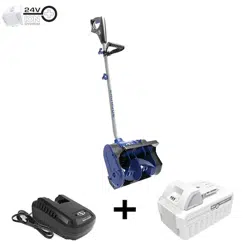Loading ...

2
exercised when handling batteries. The following points must
be obeyed at all times to ensure safe use. Safe use can only
be guaranteed if undamaged cells are used. Incorrect handling
of the battery packs can cause cell damage.
IMPORTANT! Analyses conrm that incorrect use and poor
care of high‑performance batteries are the main factors
responsible for product damage and/or personal injury.
mWARNING! To reduce the risk of injury, use only official
24V iON+ designated chargers and battery packs. The use of
other batteries or chargers poses a risk of fire, personal injury
and damage.
mWARNING! Do not use a battery pack or product
that has been damaged or modified. Damaged or modified
batteries may exhibit unpredictable behavior resulting in fire,
explosion or risk of injury.
Do not modify or attempt to repair the product or the battery
pack except as indicated in the instructions for use and care.
Do not wire a battery pack to a power supply or car cigarette
lighter, as such misuse will permanently disable or damage the
battery pack.
Have your battery pack serviced by a qualied repair person
using only identical replacement parts. This will ensure that the
safety of the battery pack is maintained.
mWARNING! To reduce the risk of electric shock,
always unplug the charger before performing any cleaning
or maintenance. Do not allow water to flow into the charger.
Use a Ground Fault Circuit Interrupter (GFCI) to reduce shock
hazards.
• Remove battery – Remove the battery pack from the tool
when not in use, before servicing, or before performing
any other maintenance task. Never leave the tool
unattended while switched on. In the event of an accident
or breakdown, switch off the tool immediately.
• Avoid dangerous environments – Do not charge the
battery packs in rain, snow or in damp or wet locations.
Do not use the battery pack or charger in the presence
of explosive atmospheres (gaseous fumes, dust or
flammable materials) because sparks may be generated
when inserting or removing the battery packs, which could
lead to a fire.
NOTE: The safe temperature range for the batteries are
41°F (5°C) to 105°F (40.5°C). Do not charge the batteries
outside in freezing weather; charge them at room
temperature.
• Charge in a well‑ventilated area – Do not block the
charger vents. Keep them clear to allow for proper
ventilation. Do not allow smoking or open flames near a
charging battery pack. Vented gases may explode.
• Maintain charger cord – When unplugging the charger,
pull the plug, not the cord from the receptacle to reduce
the risk of damage to the power cord. Never carry the
charger by its cord. Keep the cord away from heat, oil and
sharp edges. Make sure the cord will not be stepped on,
tripped over or subjected to damage or stress when the
charger is in use. Do not use a charger with a damaged
cord or plug. Replace a damaged charger immediately.
• Do not use an extension cord unless it is absolutely
necessary – Using the wrong, damaged or improperly
wired extension cord poses a risk of fire and electric
shock. If an extension cord must be used, plug the
charger into a properly wired 16 gauge or larger extension
cord with the female plug matching the male plug on the
charger. Make sure that the extension cord is in good
electrical condition.
• Do not expose the machine or battery packs to fire –
Exposure to fire or temperatures above 265°F (130°C)
may cause the battery packs to explode, causing personal
injury or damage. Toxic fumes and materials are created
when battery packs are ignited.
• Do not crush, drop or damage battery packs –
Do not use the battery packs or charger if they have
sustained a sharp blow, been dropped from a height
of more than 3 feet (1 meter), run over or have been
damaged in any way. Even if the housing of a battery
pack appears to be undamaged, the battery cells inside
the battery may have suffered serious damage. In such
instances, please read the waste disposal information for
proper battery disposal.
• Do not disassemble – Incorrect reassembly may pose
a serious risk of electric shock, fire or exposure to toxic
battery chemicals. If the battery or charger is damaged,
contact an authorized Snow Joe
®
+ Sun Joe
®
dealer or
call the Snow Joe
®
+ Sun Joe
®
customer service center at
1‑866‑SNOWJOE (1‑866‑766‑9563) for assistance.
• Battery chemicals cause serious burns – Never let a
damaged battery pack contact the skin, eyes or mouth.
If damaged, battery chemicals will react violently with air.
Use rubber or neoprene gloves to safely dispose of the
battery. If skin is exposed to battery chemicals, wash the
affected area with soap and water. If eyes are exposed
to battery chemicals, immediately flush with water for 20
minutes and seek medical attention. Remove and dispose
of contaminated clothing.
• Risk of short circuit – A battery pack will short circuit if
a metal object makes a connection between the positive
and negative contacts on the battery pack. Do not place a
battery pack near anything that may cause a short circuit,
such as paperclips, coins, keys, screws, nails and other
metallic objects. A short‑circuited battery pack poses a
risk of fire and severe personal injury.
• Store your battery packs and charger in a cool, dry
place – Ideally, store the battery packs at 59°F (15°C) and
charged to at least 40%. Do not store the battery packs or
charger where temperatures may exceed 105ºF (40.5ºC),
such as in direct sunlight or inside a vehicle, or where
temperatures may drop below 41°F (5°C).
NOTE: Prevent the battery packs from freezing. Battery
packs that were stored below 32°F (0°C) for more than 60
minutes must be discarded.
• Charge before use – The battery pack supplied with your
Loading ...
Loading ...
Loading ...
